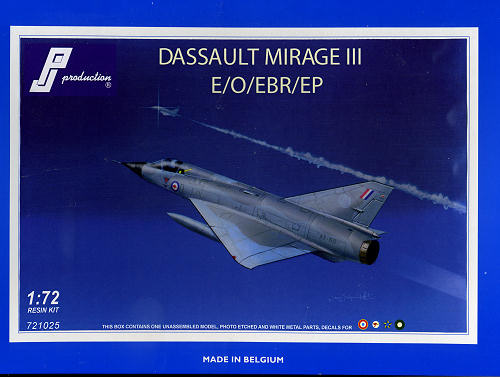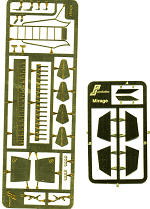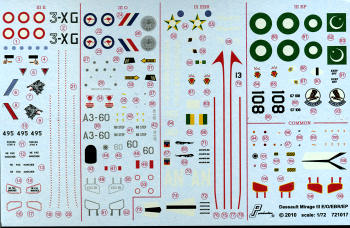
PJ Production 1/72 Mirage IIIE/O/EBR/EP
| KIT #: | 721025 |
| PRICE: | €41.50 from PJ Production |
| DECALS: | Four options |
| REVIEWER: | Scott Van Aken |
| NOTES: | Resin kit with photo etch, cast metal and vacuform parts |

| HISTORY |
While the Mirage IIIC was being put into production, Dassault was also considering a multi-role/strike variant of the aircraft, which eventually materialized as the
Mirage IIIE. The first of three prototypes flew on 1 April 1961.The Mirage IIIE differed from the IIIC interceptor most obviously in having a 300 mm (11.8 in) forward fuselage extension to increase the size of the avionics bay behind the cockpit. The stretch also helped increase fuel capacity, as the Mirage IIIC had marginal range and improvements were needed. The stretch was small and hard to notice, but the clue is that the bottom edge of the canopy on a Mirage IIIE ends directly above the top lip of the air intake, while on the IIIC it ends visibly back of the lip.
Many Mirage IIIE variants were also fitted with a Marconi continuous-wave Doppler navigation radar radome on the bottom of the fuselage, under the cockpit. However, while no IIICs had this feature, it was not universal on all variants of the IIIE. A similar inconsistent variation in Mirage fighter versions was the presence or absence of an HF antenna that was fitted as a forward extension to the vertical tailplane. On some Mirages, the leading edge of the tailplane was a straight line, while on those with the HF antenna the leading edge had a sloping extension forward. The extension appears to have been generally standard on production Mirage IIIAs and Mirage IIICs, but only appeared in some of the export versions of the Mirage IIIE.
The IIIE featured Thomson-CSF Cyrano II dual mode air / ground radar; a radar warning receiver (RWR) system with the antennas mounted in the vertical tailplane; and an Atar 09C engine, with a petal-style variable exhaust.
The first production Mirage IIIE was delivered to the AdA in January 1964, and a total of 192 were eventually delivered to that service.
Total production of the Mirage IIIE, including exports, was substantially larger than that of the Mirage IIIC, including exports, totaling 523 aircraft. In the mid-1960s one Mirage IIIE was fitted with the improved SNECMA Atar 09K-6 turbojet for trials, and given the confusing designation of
Mirage IIIC2.| THE KIT |
 What has been lacking for decades is a well done injected plastic 1/72 Mirage IIIE. Sure, there is the Heller kit, but that is rather long in the tooth and not up to modern standards. Why one has not come out of Korea or China is beyond me, but fortunately for us all PJ Production has had a quality resin kit which gets reissued in a variety of guises from time to time. This time, it is being produced as an aircraft used by France, Australia, Brazil and Pakistan. What's more, it has all the various bits and pieces to do the differing variations appropriate to the country of use.
What has been lacking for decades is a well done injected plastic 1/72 Mirage IIIE. Sure, there is the Heller kit, but that is rather long in the tooth and not up to modern standards. Why one has not come out of Korea or China is beyond me, but fortunately for us all PJ Production has had a quality resin kit which gets reissued in a variety of guises from time to time. This time, it is being produced as an aircraft used by France, Australia, Brazil and Pakistan. What's more, it has all the various bits and pieces to do the differing variations appropriate to the country of use.
For instance, it has the extended fin fillet for the Brazilian version as well as the canards used by Brazil. There is the under nose Doppler antenna that the French and the Brazilian Mirage IIIs used. A separate fin with the ESM antennas molded in as used by the French is also included. Then there is the ILS antennas and well, you get the idea that this is one very comprehensive kit.
As I mentioned, the molds for this one have been used in several different boxings and so it isn't all that surprising that a few molding glitches have appeared. For instance, on the upper spine of one fuselage half, there are a couple of areas that look 'melted', so will have to be filled and rescribed. I also found some air bubbles along the edge of the ventral piece that used to hold the rocket motor. These are all minor, and experienced resin kit builders expect to find these.
 The general detail of the kit is superb. Crisply engraved panel lines, full cockpit and nose gear well detail molded into the fuselage halves, a detailed bang seat. Three optional fuel tank sizes complete with photo etch fins, two vacuformed canopies (on which I found the frame lines a bit indistinct) and optional outer wing pylons are included. There are no weapons in with the kit, but I'm sure they are not going to be difficult to find as spares from other kits or in weapons sets. The photo etch includes the aforementioned tank fins, an access ladder, oleo scissors, some small antennas, canopy mirrors, the intake splitter plates, exhaust afterburner detail and some other smaller bits.
The general detail of the kit is superb. Crisply engraved panel lines, full cockpit and nose gear well detail molded into the fuselage halves, a detailed bang seat. Three optional fuel tank sizes complete with photo etch fins, two vacuformed canopies (on which I found the frame lines a bit indistinct) and optional outer wing pylons are included. There are no weapons in with the kit, but I'm sure they are not going to be difficult to find as spares from other kits or in weapons sets. The photo etch includes the aforementioned tank fins, an access ladder, oleo scissors, some small antennas, canopy mirrors, the intake splitter plates, exhaust afterburner detail and some other smaller bits.
 Instructions are superbly drawn and comprise eight building steps. Optional parts use is indicated depending on the version you are doing. In this regard, one pretty well needs to know from the start which variant is being built. There are notes on cockpit and gear/well colors. The markings and camo guide is in full color. As mentioned, there are four options. A French IIIE from EC.3/3 in 1991 wearing standard French European Camo. Also in this scheme is the Pakistan AF IIIEP. In a two tone grey scheme reminiscent of the US F-15 is an Australian IIIO from 1983. This was the last scheme worn as earlier Aussie Mirages were in the French European scheme. Finally, a Brazilian IIIEBR in their 1990s scheme of dark grey over light grey with tail codes. The decals are well printed and glossy, reminding me somewhat of Modeldecals, though these appear thinner.
Instructions are superbly drawn and comprise eight building steps. Optional parts use is indicated depending on the version you are doing. In this regard, one pretty well needs to know from the start which variant is being built. There are notes on cockpit and gear/well colors. The markings and camo guide is in full color. As mentioned, there are four options. A French IIIE from EC.3/3 in 1991 wearing standard French European Camo. Also in this scheme is the Pakistan AF IIIEP. In a two tone grey scheme reminiscent of the US F-15 is an Australian IIIO from 1983. This was the last scheme worn as earlier Aussie Mirages were in the French European scheme. Finally, a Brazilian IIIEBR in their 1990s scheme of dark grey over light grey with tail codes. The decals are well printed and glossy, reminding me somewhat of Modeldecals, though these appear thinner.| CONCLUSIONS |
I dare say that this is probably the best Mirage IIIE kit in 1/72 scale. It has all the detail one would want and is well done to boot. If the Mirage is your favorite aircraft, then you really need to look into picking this one up.
| REFERENCES |
http://en.wikipedia.org/wiki/Mirage_III February 2011
Thanks to PJ Production for the preview kit. Get yours at the link. If you would like your product reviewed fairly and fairly quickly, please contact the editor or see other details in the